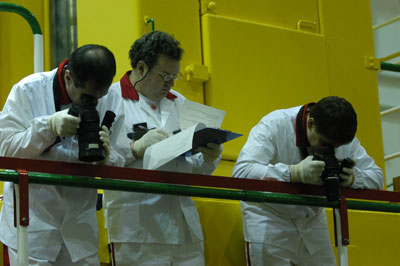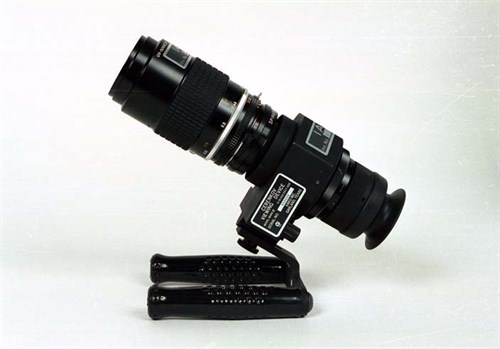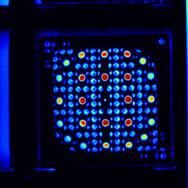
The handheld Cerenkov Viewing Device (ICVD), such as those seen being used in this photograph, is an image-intensifier viewing device sensitive to the ultraviolet radiation which can be found in the water in which spent fuel is immersed.
(Source:
Dean Calma/IAEA)
A method for qualitative verification of irradiated nuclear fuel
in storage pools. Irradiated fuel emits fast electrons that induce
a characteristic blue glow in water. Electro-optical image
intensifiers have been adapted to observe this glow from above a
storage pool. They are optimized for ultraviolet radiation and are
capable of operating with facility lights turned on. When aligned
vertically above the tops of fuel assemblies, a Cerenkov viewing
device can distinguish irradiated fuel items from non-fuel
items.
The improved Cerenkov viewing device (ICVD) and the digital
Cerenkov viewing device (DCVD) are image intensifier viewing
devices that are sensitive to ultraviolet radiation in the water
surrounding spent fuel assemblies. The hand-held ICVD (Fig. 16) is
the instrument most commonly used by safeguards inspectors to
obtain qualitative confirmation (attribute testing) of the presence
of spent fuel in storage pools. The viewing device is capable of
operating with facility lights turned on in the spent fuel pond
area. The ICVD is optimized for ultraviolet radiation by filtering
away most of the visible light and by having an image intensifier
tube primarily sensitive to the ultraviolet light frequencies.
Cerenkov radiation is derived from the intense γ radiation
emanating from spent fuel, which, when absorbed in the water,
produces high energy recoil electrons. In many cases these
electrons exceed the speed of light in water (which is slower than
the speed of light in a vacuum) and therefore must lose energy by
emitting radiation (Cerenkov radiation). Spent fuel also emits β
particles (which are also energetic electrons), adding to the
Cerenkov radiation. Spent fuel assemblies are characterized by
Cerenkov glow patterns that are bright in the regions immediately
adjacent to the fuel rods. The variation in light intensity is
apparent when viewed from a position aligned directly above the
fuel rods. With careful alignment and appropriate assessment of the
object being viewed, an irradiated fuel assembly can be
distinguished from a non-fuel item that may look the same to the
naked eye. Typically, a row of fuel assemblies is viewed vertically
from the bridge while the facility operator slowly runs the bridge
down the row. One inspector views the items in the row through the
ICVD and verbally declares each item as spent fuel, as a void or as
some other object, while a second inspector compares the observed
results with the facility declarations.
The DCVD is used to verify assemblies with long cooling times
and/or low burnups, which have weak Cerenkov signals that cannot be
seen with a standard ICVD. Apart from its higher sensitivity, the
DCVD can record and document individual scans for subsequent
re-analysis. It has the potential to quantify the Cerenkov glow
from spent fuel assemblies as a function of irradiation history and
cooling time.

Improved Cerenkov Viewing Device
(ICVD)
(Source: IAEA Safeguards Techniques and Equipment)

Picture taken from the top of a
spent fuel assembly with a Digital Cerenkov Viewing Device (Source:
IAEA-CN-184/338).